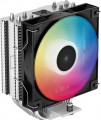Add to comparison |  |  |
|---|---|---|
| Deepcool AG400 ARGB Black | Deepcool AG400 LED | |
| Compare prices 6 | Outdated Product | |
| User reviews | ||
| TOP sellers | ||
Main specs | ||
| Features | for CPU | for CPU |
| Product type | air cooler | air cooler |
| Air flow direction | sideways (dispersion) | sideways (dispersion) |
| Max. TDP | 220 W | 220 W |
Fan | ||
| Number of fans | 1 | 1 |
| Fan size | 120 mm | 120 mm |
| Bearing | hydrodynamic | hydrodynamic |
| Min. RPM | 500 rpm | 500 rpm |
| Max. RPM | 2000 rpm | 2000 rpm |
| Speed controller | auto (PWM) | auto (PWM) |
| Max. air flow | 75.89 CFM | 75.89 CFM |
| Static pressure | 2.53 mm H2O | 2.53 mm H2O |
| replaceable | ||
| Noise level | 32 dB | 32 dB |
| Power source | 4-pin | 4-pin |
Radiator | ||
| Heat pipes | 4 | 4 |
| Heatpipe contact | straight | straight |
| Heatsink material | aluminium / copper | aluminium / copper |
| Plate material | aluminium | aluminium |
| Socket | AMD AM4 AMD AM5 Intel 1150 Intel 1155/1156 Intel 1151 / 1151 v2 Intel 1200 Intel 1700 / 1851 | AMD AM4 AMD AM5 Intel 1150 Intel 1155/1156 Intel 1151 / 1151 v2 Intel 1200 Intel 1700 / 1851 |
General | ||
| Lighting | ||
| Lighting colour | ARGB | |
| Lighting sync | multi compatibility | |
| Mount type | bilateral (backplate) | bilateral (backplate) |
| Dimensions | 125x92x150 mm | 125x92x150 mm |
| Height | 150 mm | 150 mm |
| Weight | 614 g | 614 g |
| Added to E-Catalog | november 2022 | november 2022 |